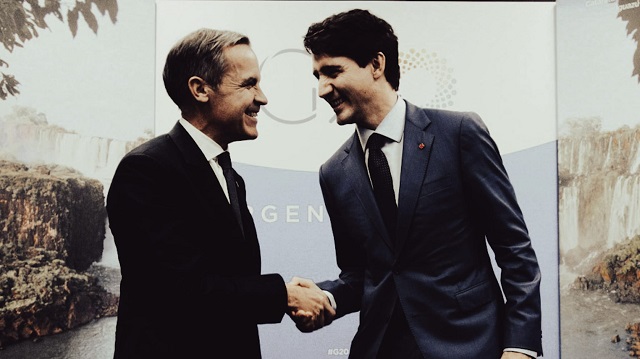Frontier Centre for Public Policy
Mark Carney’s Leadership Win Mirrors Past Liberal Failures

From the Frontier Centre for Public Policy
By Lee Harding
The Liberal Party has crowned Mark Carney leader, but his path to victory is riddled with obstacles
The Liberal Party of Canada has selected a non-MP to become prime minister, but precedent suggests he won’t last long. Mark Carney represents the worst aspects of both John Turner’s and Michael Ignatieff’s political rises and appears destined for the same electoral futility.
When Pierre Trudeau stepped down as Liberal leader in 1984 after more than 15 years as prime minister, he left behind a parting gift: over 200 Liberal patronage appointments. His successor, John Turner, agreed to another 70. These appointments became a burden, weighing down Turner’s leadership before it had even begun. Like Carney, Turner was not a sitting MP when he became leader. Forced to call a snap election, he watched the Progressive Conservatives secure the first of two successive majorities.
Now, history is repeating itself. Justin Trudeau’s cabinet made 70 appointments in its final days, including 12 judges. That number doesn’t include the 10 senators he appointed while Parliament was prorogued—nearly 10 per cent of the 105-seat chamber. Like Turner, Carney must navigate a leadership legacy tainted by patronage and an unpopular outgoing prime minister.
But does Carney’s experience, reputation, and distance from Trudeau offer him a fresh start? It seems unlikely. Unlike Turner, Carney has never held elected office.
Turner at least had a political track record. As a cabinet minister under two prime ministers, he handled high-profile Justice and Finance portfolios. He also benefited from a nine-year break from politics, distancing himself from the unpopular Trudeau. None of it mattered. Turner still lost.
Liberals hope Carney can ride a wave of popularity after a dominant leadership victory, securing 85 per cent support. But what did he really win? A former central banker, he climbed atop a heap of ruins.
His victory over Chrystia Freeland, Karina Gould, and former MP Frank Baylis was less a competitive race and more a coronation. Freeland carried the baggage of Trudeau’s policies, while the other two lacked national recognition. Carney, the only contender without direct ties to Trudeau’s government, was the default choice. The Liberal Party is adrift, and he simply took the helm.
But winning an uncontested leadership race is no guarantee of electoral success. Turner’s rise in 1984 was far more hard-fought—he overcame political heavyweights, including Jean Chrétien and four other cabinet ministers, in a real contest for the party’s future. Yet despite his credentials and broad support within the party, Canadians still rejected him.
And unlike Turner, Carney’s leadership victory raises serious legitimacy concerns. Liberal leadership races allow votes from permanent residents (non-citizens) and minors aged 14 to 17—groups that have no say in a general election. Even more troubling, of the 400,000 votes cast, only 147,000 were verified. Carney received 126,000 of those votes, but nearly two-thirds of ballots were rejected. Had those votes gone to any of his opponents, Carney’s win would have been far from certain.
A Rebel News petition calling for Elections Canada, CSIS, and the RCMP to audit the leadership vote is already circulating. While skepticism over the process is reasonable, it’s doubtful that meaningful answers will emerge.
Beyond legitimacy issues, Carney shares another unfortunate trait with a failed Liberal leader: Michael Ignatieff.
Ignatieff followed Stéphane Dion, whose push for a carbon tax proved deeply unpopular. The Conservatives quickly branded Ignatieff, a long-time Harvard professor, as an elitist disconnected from ordinary Canadians. Their “He didn’t come back for you” attack ads stuck, and Ignatieff led the Liberals to a historic defeat, falling to third-party status.
Carney faces the same vulnerability. After years in England, he will struggle to shake the image of an out-of-touch globalist. His French, weaker than Ignatieff’s, will also hurt him in Quebec, a province that abandoned the Liberals in 2011 in favour of the NDP.
History suggests Carney’s leadership will pave the way for another Conservative majority government—just as Turner and Ignatieff’s failures did.
Carney’s leadership campaign combines the worst aspects of 1984 and 2011. As an unelected, elitist ex-pat with weak French, he carries a Liberal banner weighed down by both Trudeau’s baggage and the deeply unpopular carbon tax.
A Conservative government with a mandate for reform is increasingly likely. A slimmed-down civil service, reduced regulations, the abolition of the carbon tax, and renewed pipeline construction could all be on the horizon. After nearly a decade of Liberal rule, Canada’s political pendulum seems set to swing back once again.
Lee Harding is Research Fellow for the Frontier Centre for Public Policy.
Frontier Centre for Public Policy
New Book Warns The Decline In Marriage Comes At A High Cost

From the Frontier Centre for Public Policy
Travis Smith reviews I… Do? by Andrea Mrozek and Peter Jon Mitchell, showing that marriage is a public good, not just private choice, arguing culture, not politics, must lead any revival of this vital institution.
Andrea Mrozek and Peter Jon Mitchell, in I… Do?, write that the fading value of marriage is a threat to social stability
I… Do? by Andrea Mrozek and Peter Jon Mitchell manages to say something both obvious and radical: marriage matters. And not just for sentimental reasons. Marriage is a public good, the authors attest.
The book is a modestly sized but extensively researched work that compiles decades of social science data to make one central point: stable marriages improve individual and societal well-being. Married people are generally healthier, wealthier and more resilient. Children from married-parent homes do better across almost every major indicator: academic success, mental health, future earnings and reduced contact with the justice system.
The authors refer to this consistent pattern as the “marriage advantage.” It’s not simply about income. Even in low-income households, children raised by married parents tend to outperform their peers from single-parent families. Mrozek and Mitchell make the case that marriage functions as a stabilizing institution, producing better outcomes not just for couples and kids but for communities and, by extension, the country.
While the book compiles an impressive array of empirical findings, it is clear the authors know that data alone can’t fix what’s broken. There’s a quiet but important concession in these pages: if statistics alone could persuade people to value marriage, we would already be seeing a turnaround.
Marriage in Canada is in sharp decline. Fewer people are getting married, the average age of first marriage continues to climb, and fertility rates are hitting historic lows. The cultural narrative has shifted. Marriage is seen less as a cornerstone of adult life and more as a personal lifestyle choice, often put off indefinitely while people wait to feel ready, build their careers or find emotional stability.
The real value of I… Do? lies in its recognition that the solutions are not primarily political. Policy changes might help stop making things worse, but politicians are not going to rescue marriage. In fact, asking them to may be counterproductive. Looking to politicians to save marriage would involve misunderstanding both marriage and politics. Mrozek and Mitchell suggest the best the state can do is remove disincentives, such as tax policies and benefit structures that inadvertently penalize marriage, and otherwise get out of the way.
The liberal tradition once understood that family should be considered prior to politics for good reason. Love is higher than justice, and the relationships based in it should be kept safely outside the grasp of bureaucrats, ideologues, and power-seekers. The more marriage has been politicized over recent decades, the more it has been reshaped in ways that promote dependency on the impersonal and depersonalizing benefactions of the state.
The book takes a brief detour into the politics of same-sex marriage. Mrozek laments that the topic has become politically untouchable. I would argue that revisiting that battle is neither advisable nor desirable. By now, most Canadians likely know same-sex couples whose marriages demonstrate the same qualities and advantages the authors otherwise praise.
Where I… Do? really shines is in its final section. After pages of statistics, the authors turn to something far more powerful: culture. They explore how civil society—including faith communities, neighbourhoods, voluntary associations and the arts can help revive a vision of marriage that is compelling, accessible and rooted in human experience. They point to storytelling, mentorship and personal witness as ways to rebuild a marriage culture from the ground up.
It’s here that the book moves from description to inspiration. Mrozek and Mitchell acknowledge the limits of top-down efforts and instead offer the beginnings of a grassroots roadmap. Their suggestions are tentative but important: showcase healthy marriages, celebrate commitment and encourage institutions to support rather than undermine families.
This is not a utopian manifesto. It’s a realistic, often sobering look at how far marriage has fallen off the public radar and what it might take to put it back. In a political climate where even mentioning marriage as a public good can raise eyebrows, I… Do? attempts to reframe the conversation.
To be clear, this is not a book for policy wonks or ideologues. It’s for parents, educators, community leaders and anyone concerned about social cohesion. It’s for Gen Xers wondering if their children will ever give them grandchildren. It’s for Gen Zers wondering if marriage is still worth it. And it’s for those in between, hoping to build something lasting in a culture that too often encourages the opposite.
If your experiences already tell you that strong, healthy marriages are among the greatest of human goods, I… Do? will affirm what you know. If you’re skeptical, it won’t convert you overnight, but it might spark a much-needed conversation.
Travis D. Smith is an associate professor of political science at Concordia University in Montreal. This book review was submitted by the Frontier Centre for Public Policy.
Carbon Tax
Canada’s Carbon Tax Is A Disaster For Our Economy And Oil Industry

From the Frontier Centre for Public Policy
By Lee Harding
Lee Harding exposes the truth behind Canada’s sky-high carbon tax—one that’s hurting our oil industry and driving businesses away. With foreign oil paying next to nothing, Harding argues this policy is putting Canada at a major economic disadvantage. It’s time to rethink this costly approach.
Our sky-high carbon tax places Canadian businesses at a huge disadvantage and is pushing investment overseas
No carbon tax will ever satisfy global-warming advocates, but by most measures, Canada’s carbon tax is already too high.
This unfortunate reality was brought to light by Resource Works, a B.C.-based non-profit research and advocacy organization. In March, one of their papers outlined the disproportionate and damaging effects of Canada’s carbon taxes.
The study found that the average carbon tax among the top 20 oil-exporting nations, excluding Canada, was $0.70 per tonne of carbon emissions in fiscal 2023. With Canada included, that average jumps to $6.77 per tonne.
At least Canada demands the same standards for foreign producers as it does for domestic ones, right? Wrong.
Most of Canada’s oil imports come from the U.S., Saudi Arabia, and Nigeria, none of which impose a carbon tax. Only 2.8 per cent of Canada’s oil imports come from the modestly carbon-taxing countries of the U.K. and Colombia.
Canada’s federal consumer carbon tax was $80 per tonne, set to reach $170 by 2030, until Prime Minister Mark Carney reduced it to zero on March 14. However, parallel carbon taxes on industry remain in place and continue to rise.
Resource Works estimates Canada’s effective carbon tax at $58.94 per tonne for fiscal 2023, while foreign oil entering Canada had an effective tax of just $0.30 per tonne.
“This results in a 196-fold disparity, effectively functioning as a domestic tariff against Canadian oil production,” the research memo notes. Forget Donald Trump—Ottawa undermines our country more effectively than anyone else.
Canada is responsible for 1.5 per cent of global CO2 emissions, but the study estimates that Canada paid one-third of all carbon taxes in 2023. Mexico, with nearly the same emissions, paid just $3 billion in carbon taxes for 2023-24, far less than Canada’s $44 billion.
Resource Works also calculated that Canada alone raised the global per-tonne carbon tax average from $1.63 to $2.44. To be Canadian is to be heavily taxed.
Historically, the Canadian dollar and oil and gas investment in Canada tracked the global price of oil, but not anymore. A disconnect began in 2016 when the Trudeau government cancelled the Northern Gateway pipeline and banned tanker traffic on B.C.’s north coast.
The carbon tax was introduced in 2019 at $15 per tonne, a rate that increased annually until this year. The study argues this “economic burden,” not shared by the rest of the world, has placed Canada at “a competitive disadvantage by accelerating capital flight and reinforcing economic headwinds.”
This “erosion of energy-sector investment” has broader economic consequences, including trade balance pressures and increased exchange rate volatility.
According to NASA, Canadian forest fires released 640 million metric tonnes of carbon in 2023, four times the amount from fossil fuel emissions. We should focus on fighting fires, not penalizing our fossil fuel industry.
Carney praised Canada’s carbon tax approach in his 2021 book Value(s), raising questions about how long his reprieve will last. He has suggested raising carbon taxes on industry, which would worsen Canada’s competitive disadvantage.
In contrast, Conservative leader Pierre Poilievre argued that extracting and exporting Canadian oil and gas could displace higher-carbon-emitting energy sources elsewhere, helping to reduce global emissions.
This approach makes more sense than imposing disproportionately high tax burdens on Canadians. Taxes won’t save the world.
Lee Harding is a research fellow for the Frontier Centre for Public Policy.
-

 Business2 days ago
Business2 days agoCarney government should recognize that private sector drives Canada’s economy
-

 Alberta2 days ago
Alberta2 days agoAlberta school boards required to meet new standards for school library materials with regard to sexual content
-

 Alberta2 days ago
Alberta2 days agoFourteen regional advisory councils will shape health care planning and delivery in Alberta
-

 Crime1 day ago
Crime1 day agoSweeping Boston Indictment Points to Vast Chinese Narco-Smuggling and Illegal Alien Labor Plot via Mexican Border
-

 Business19 hours ago
Business19 hours agoCBC six-figure salaries soar
-

 Business2 days ago
Business2 days agoCannabis Legalization Is Starting to Look Like a Really Dumb Idea
-

 Bruce Dowbiggin2 days ago
Bruce Dowbiggin2 days agoThe Covid 19 Disaster: When Do We Get The Apologies?
-

 Environment1 day ago
Environment1 day agoEPA releases report on chemtrails, climate manipulation





